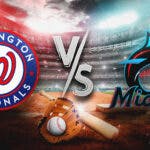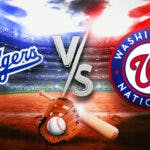The Washington Nationals are just a couple years removed from the first World Series in franchise history, but their future outlook might be worse than any club in the majors.
Let's start with 2021. The Nationals hoped to rebound from a poor 2020 and reassert their contender status in the National League East. It hasn't happened. Washington came into Thursday's game with the Atlanta Braves at 23-29. The Nationals rank 22nd in runs per game, while the pitching staff ranks 17th in ERA.
It's deeper than that, especially as far as the pitching staff is concerned. Max Scherzer has been terrific, while Jon Lester has been a serviceable back-end arm. Everyone else has struggled, and Stephen Strasburg is back on the injured list yet again with a nerve issue. Meanwhile, the bullpen ranks 18th in xFIP.
The Nationals just don't appear to have the makings of a contender, not with the issues in the rotation and an offense that has struggled to perform in high leverage spots and with runners in scoring position.
Washington could be in “sell” mode come deadline season. Yet, it might mark just the beginning of what could be a painful sort of retool.
Nationals have no farm
The Nationals have one of the worst farm systems in baseball. They already had limited assets before trading a pair of top-10 prospects for Josh Bell, who is hitting just .208 with a .668 OPS entering Thursday's action.
Indeed, MLB.com ranked Washington's farm system as the worst in baseball in March. On the one hand, selling trade assets ahead of the deadline this July could bring back future talent. But… how much future talent can the Nationals bring back?
Scherzer is one of the top arms in the game. However, considering he will be a free agent at the end of the season and is owed a lot of money in deferrals, he is unlikely to get a seismic return. The same can be said for some of Washington's other expiring contracts, such as outfielder Kyle Schwarber and reliever Daniel Hudson.
The Nationals would undoubtedly prefer to build up their farm sooner, rather than later. But that's going to take some time to accomplish.
Contractual obligations
The status of Washington's payroll is probably more concerning.
The Nationals already owe Scherzer quite a bit of money in deferrals and would likely be forced to pay down nearly all of that money even if they trade him by July. Washington is also shelling out a lot of money to two of their other arms.
Patrick Corbin is owed over $80 million through 2024. Strasburg, meanwhile, is owed $175 million through 2026. That's… a lot of money. It will be an even bigger hit to the pocket if Strasburg, who will be 33 in July, continues to be hampered by injuries.
Now, some fans might look at the future books and think “Well, the Nationals have a lot of players coming off payrolls in the next year or two.” That's true, but the above contracts loom large especially when considering Washington still has to pay its top two stars.
Shortstop Trea Turner will be a free agent after the 2022 season and could command a massive deal depending on how this winter's shortstop class fares in the open market. Juan Soto is under club control through 2024, but is also certain to command a mammoth deal and will only get more expensive throughout the arbitration process after obtaining Super-2 status.
All of this makes for some confusion for general manager Mike Rizzo and the fans in D.C. Whereas some clubs have more defined status as being in rebuilding mode or looking to win now, the Nationals are sort of caught in a painful grey area. It could be a long and arduous retool full of difficult hurdles.




